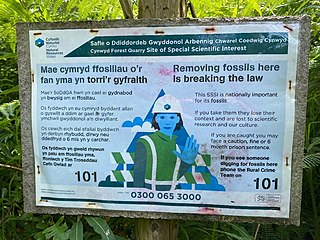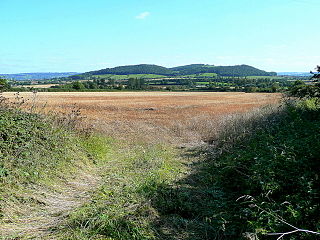
A site of special scientific interest (SSSI) in Great Britain, or an area of special scientific interest (ASSI) in the Isle of Man and Northern Ireland, is a conservation designation denoting a protected area in the United Kingdom and Isle of Man. SSSI/ASSIs are the basic building block of site-based nature conservation legislation and most other legal nature/geological conservation designations in the United Kingdom are based upon them, including national nature reserves, Ramsar sites, Special Protection Areas, and Special Areas of Conservation. The acronym "SSSI" is often pronounced "triple-S I".

The Old Man of Coniston is a fell in the Furness Fells of the Lake District in Cumbria, England, and is the highest point of the historic county of Lancashire. It is at least 2,632.62 feet (802.42 m) high, and lies to the west of the village of Coniston and the lake, Coniston Water. The fell is sometimes known by the alternative name of Coniston Old Man, or simply The Old Man. The mountain is popular with tourists and fell-walkers with a number of well-marked paths to the summit. The mountain has also seen extensive copper and slate mining activity for eight hundred years, and the remains of abandoned mines and spoil tips are a significant feature of the north-east slopes.

Fossil Mountain is located in the Teton Range, within the Jedediah Smith Wilderness of Caribou-Targhee National Forest, U.S. state of Wyoming.
The Howgill Fells are uplands in Northern England between the Lake District and the Yorkshire Dales, lying roughly within a triangle formed by the town of Sedbergh and the villages of Ravenstonedale and Tebay. The name Howgill derives from the Old Norse word haugr meaning a hill or barrow, plus gil meaning a narrow valley.
Teffont Evias Quarry and Lane Cutting is a 3.6 hectare geological Site of Special Scientific Interest at Teffont Evias in Wiltshire, England, notified in 1989. It consists of two parts, Teffont Evias Quarry, and Teffont Evias Lane Cutting. Forest trees are currently growing on both sites, but there are small accessible exposures on the sides of quarry and roadway cuttings.
Wellacre Quarry is a 12.3 hectare geological Site of Special Scientific Interest in Gloucestershire, notified in 1974. It is within the Cotswold Area of Outstanding Natural Beauty and the site was formerly known as Blockley Station Brickworks. The site is listed in the 'Cotswold District' Local Plan 2001-2011 as a Key Wildlife Site (KWS) and a Regionally Important Geological Site (RIGS).

Sometimes referred to in literature as 'Bwlch y Gaseg' and in very close proximity to the area named as such on OS Map 1888-1913, the Cynwyd Forest Quarry is a Site of Special Scientific Interest (SSSI) located aside a track within the Cynwyd Forest near Corwen, Denbighshire, North Wales. It was described by Rushton et al. (2000) and exposes Late Ordovician micaceous siltstones and mudstones of the Dolhir Formation which yields a rich shelly (brachiopod) fauna. Trilobites are represented by several genera although the fauna is dominated by Gravicalymene arcuata Price, 1982. Bivalves, bryozoans and various Echinodermata are also present. Examples of most of the fossils listed below are illustrated and briefly described in "Fossils of the Upper Ordovician" by Harper and Owen (Eds.).

Alderton Hill Quarry is a 0.34-hectare (0.84-acre) geological Site of Special Scientific Interest in Gloucestershire, notified in 1997. It is a Geological Conservation Review (GCR) site.

Coaley Wood Quarries is a 4.85-hectare (12.0-acre) geological Site of Special Scientific Interest in Gloucestershire, notified in 1974.

Minchinhampton Common is a 182.7-hectare (451-acre) biological and geological Site of Special Scientific Interest in Minchinhampton, Gloucestershire, England, notified in 1972.
Puddlebrook Quarry is a 0.7-hectare (1.7-acre) geological Site of Special Scientific Interest in Gloucestershire, near Drybrook notified in 1986. The site is listed in the 'Forest of Dean Local Plan Review' as a Key Wildlife Site (KWS).
Robeston Wathen Quarries is a Site of Special Scientific Interest in Pembrokeshire, South Wales, immediately to the north of the village of Robeston Wathen. It has been designated as a Site of Special Scientific Interest since January 1967 in an attempt to protect its fragile geological elements. The site has an area of 1.64 hectares and is managed by Natural Resources Wales.

The Dent Group is a group of Upper Ordovician sedimentary and volcanic rocks in north-west England. It is the lowermost part of the Windermere Supergroup, which was deposited in the foreland basin formed during the collision between Laurentia and Avalonia. It lies unconformably on the Borrowdale Volcanic Group. This unit was previously known as the Coniston Limestone Group or Coniston Limestone Formation and should not be confused with the significantly younger Coniston Group.
Brunton Bank Quarry is a disused quarry now designated as a Site of Special Scientific Interest (SSSI) in Northumberland, North East England. The quarry exposes a base layer of the Namurian Great Limestone stratigraphic unit, including the Chaetetes Band, the fossilised fauna within which is of current geological interest.
The geology of the Yorkshire Dales National Park in northern England largely consists of a sequence of sedimentary rocks of Ordovician to Permian age. The core area of the Yorkshire Dales is formed from a layer-cake of limestones, sandstones and mudstones laid down during the Carboniferous period. It is noted for its karst landscape which includes extensive areas of limestone pavement and large numbers of caves including Britain's longest cave network.
The geology of Staffordshire in the West Midlands region of England is largely characterised by sedimentary bedrock of late Palaeozoic to early Mesozoic age overlain by a suite of superficial materials deposited during the Quaternary period. The extraction of coal, limestone and clay have been significant industries within the county.
Ledbury Cutting is a Site of Special Scientific Interest near Ledbury, Hereforshire, England. The protected area is centred on a railway cutting on the Worcester and Hereford Railway, near to the entrance to the Ledbury Tunnel. The protected area is important because of the fossils of jawed fishes found in the local sediments.
Greenleighton Quarry is a Site of Special Scientific Interest (SSSI) in Northumberland, England. It is located near the village of Rothley. This protected area is renowned for its Brachiopod fossils and is owned by the National Trust.
Scawgill and Blaze Beck is a Site of Special Scientific Interest (SSSI) within the Lake District National Park in Cumbria, England. It is located 2km east of Lorton on the western side of Whinlatter Pass. This protected area consists of two quarries and a stream gorge. The fossil graptolites found here make this an exceptional site for understanding the geological stratigraphy of Ordovician rocks.








